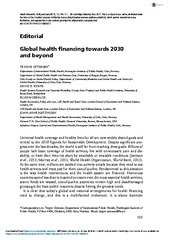Global health financing towards 2030 and beyond
Journal article
Published version

Åpne
Permanent lenke
https://hdl.handle.net/1956/18185Utgivelsesdato
2017-04Metadata
Vis full innførselSamlinger
Originalversjon
https://doi.org/10.1017/s1744133116000372Sammendrag
Universal health coverage and healthy lives for all are now widely shared goals and central to the 2030 Agenda for Sustainable Development. Despite significant progress over the last decades, the world is still far from reaching these goals. Billions of people lack basic coverage of health services, live with unnecessary pain and disability, or have their lives cut short by avoidable or treatable conditions (Jamison et al., 2013; Murray et al., 2015; World Health Organization, World Bank, 2015). At the same time, millions are pushed into poverty simply because they need to use health services and must pay for them out-of-pocket. Fundamental to this situation is the way health interventions and the health system are financed. Numerous countries spend less than is required to ensure even the most essential health services, scarce funds are wasted, out-of-pocket payments remain high and disadvantaged groups get the least public resources despite having the greatest needs. It is clear that today’s global and national arrangements for health financing need to change, and this is a multifaceted endeavour. It is about domestic financing of health systems, joint financing of global public goods and external financing of health systems. It is about resource mobilisation, pooling and effective use. And it is about economics, politics, public health, human rights, law and ethics. To get health financing right, these areas, functions and perspectives must all be integrated and aligned.
